Evidence for a functionally relevant rocaglamide binding site on the eIF4A-RNA complex
- PMID: 23614532
- PMCID: PMC3796129
- DOI: 10.1021/cb400158t
Evidence for a functionally relevant rocaglamide binding site on the eIF4A-RNA complex
Abstract
Translation initiation is an emerging target in oncology and neurobiology indications. Naturally derived and synthetic rocaglamide scaffolds have been used to interrogate this pathway; however, there is uncertainty regarding their precise mechanism(s) of action. We exploited the genetic tractability of yeast to define the primary effect of both a natural and a synthetic rocaglamide in a cellular context and characterized the molecular target using biochemical studies and in silico modeling. Chemogenomic profiling and mutagenesis in yeast identified the eIF (eukaryotic Initiation Factor) 4A helicase homologue as the primary molecular target of rocaglamides and defined a discrete set of residues near the RNA binding motif that confer resistance to both compounds. Three of the eIF4A mutations were characterized regarding their functional consequences on activity and response to rocaglamide inhibition. These data support a model whereby rocaglamides stabilize an eIF4A-RNA interaction to either alter the level and/or impair the activity of the eIF4F complex. Furthermore, in silico modeling supports the annotation of a binding pocket delineated by the RNA substrate and the residues identified from our mutagenesis screen. As expected from the high degree of conservation of the eukaryotic translation pathway, these observations are consistent with previous observations in mammalian model systems. Importantly, we demonstrate that the chemically distinct silvestrol and synthetic rocaglamides share a common mechanism of action, which will be critical for optimization of physiologically stable derivatives. Finally, these data confirm the value of the rocaglamide scaffold for exploring the impact of translational modulation on disease.
Figures
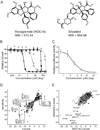
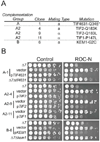
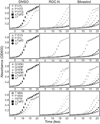
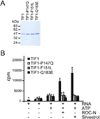
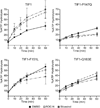
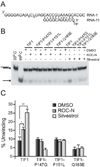
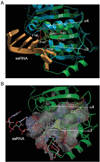
Similar articles
-
Strategic Diastereoselective C1 Functionalization in the Aza-Rocaglamide Scaffold toward Natural Product-Inspired eIF4A Inhibitors.Org Lett. 2020 Aug 21;22(16):6257-6261. doi: 10.1021/acs.orglett.0c01944. Epub 2020 Jul 30. Org Lett. 2020. PMID: 32806219
-
eIF4F: a retrospective.J Biol Chem. 2015 Oct 2;290(40):24091-9. doi: 10.1074/jbc.R115.675280. Epub 2015 Aug 31. J Biol Chem. 2015. PMID: 26324716 Free PMC article. Review.
-
Distinct interactions of eIF4A and eIF4E with RNA helicase Ded1 stimulate translation in vivo.Elife. 2020 May 29;9:e58243. doi: 10.7554/eLife.58243. Elife. 2020. PMID: 32469309 Free PMC article.
-
Structural and functional similarities between the central eukaryotic initiation factor (eIF)4A-binding domain of mammalian eIF4G and the eIF4A-binding domain of yeast eIF4G.Biochem J. 2001 Apr 1;355(Pt 1):223-30. doi: 10.1042/0264-6021:3550223. Biochem J. 2001. PMID: 11256967 Free PMC article.
-
Rocaglamide, silvestrol and structurally related bioactive compounds from Aglaia species.Nat Prod Rep. 2014 Jul;31(7):924-39. doi: 10.1039/c4np00006d. Epub 2014 May 2. Nat Prod Rep. 2014. PMID: 24788392 Free PMC article. Review.
Cited by
-
Brazilian essential oils as source for the discovery of new anti-COVID-19 drug: a review guided by in silico study.Phytochem Rev. 2021;20(5):1013-1032. doi: 10.1007/s11101-021-09754-4. Epub 2021 Apr 13. Phytochem Rev. 2021. PMID: 33867898 Free PMC article. Review.
-
A second-generation eIF4A RNA helicase inhibitor exploits translational reprogramming as a vulnerability in triple-negative breast cancer.Proc Natl Acad Sci U S A. 2024 Jan 23;121(4):e2318093121. doi: 10.1073/pnas.2318093121. Epub 2024 Jan 17. Proc Natl Acad Sci U S A. 2024. PMID: 38232291 Free PMC article.
-
The MNK1/2-eIF4E Axis as a Potential Therapeutic Target in Melanoma.Int J Mol Sci. 2020 Jun 5;21(11):4055. doi: 10.3390/ijms21114055. Int J Mol Sci. 2020. PMID: 32517051 Free PMC article. Review.
-
Enzymatic and Molecular Characterization of Anti-Leishmania Molecules That Differently Target Leishmania and Mammalian eIF4A Proteins, LieIF4A and eIF4AMus.Molecules. 2022 Sep 10;27(18):5890. doi: 10.3390/molecules27185890. Molecules. 2022. PMID: 36144626 Free PMC article.
-
Chinese herb derived-Rocaglamide A is a potent inhibitor of pancreatic cancer cells.Am J Transl Res. 2016 Feb 15;8(2):1047-54. eCollection 2016. Am J Transl Res. 2016. PMID: 27158390 Free PMC article.
References
-
- Silvera D, Formenti SC, Schneider RJ. Translational control in cancer. Nat. Rev. Cancer. 2010;10:254–266. - PubMed
-
- Blagden SP, Willis AE. The biological and therapeutic relevance of mRNA translation in cancer. Nat. Rev. Clin. Oncol. 2011;8:280–291. - PubMed
-
- Lee SK, Cui B, Mehta RR, Kinghorn AD, Pezzuto JM. Cytostatic mechanism and antitumor potential of novel 1H-cyclopenta[b]benzofuran lignans isolated from Aglaia elliptica. Chem. Biol. Interact. 1998;115:215–228. - PubMed
Publication types
MeSH terms
Substances
Grants and funding
LinkOut - more resources
Full Text Sources
Other Literature Sources
Molecular Biology Databases
Research Materials
Miscellaneous

